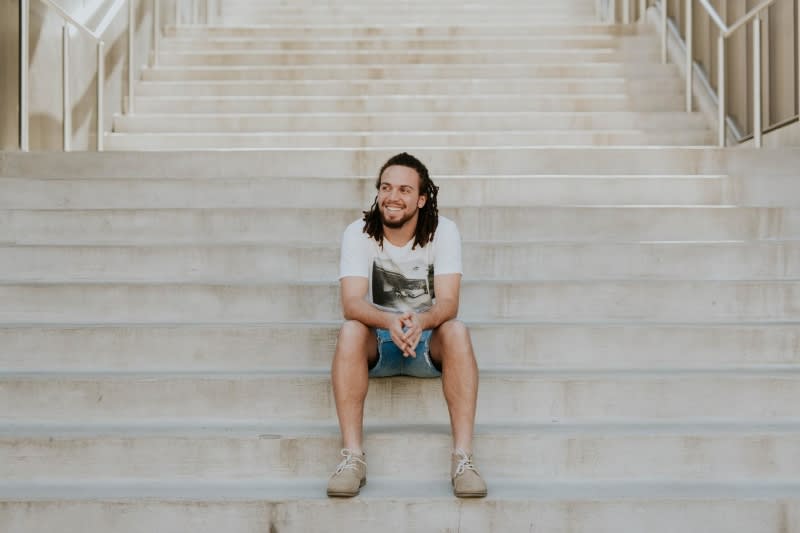I’m Losing My Hair. Does that Mean I Have to Change My Hairstyle?

When you first start losing hair, it’s normal to just stick to your usual style and try to ignore your moving hairline. But as time goes on and your hair keeps changing, you might start to have some questions, like “is it time to switch up my style?” or “should I try a hair loss treatment?” or “wait, how do I use this treatment?”
That’s why we’re dedicating this round-up to answering all of your hair styling FAQs.
Can I use hair loss treatments if I have dreadlocks?
This is a pretty common question, which could be because most ads for hair loss treatments don’t show guys with locs (or twists, or braids, or similar styles).
We’re happy to report that most FDA-approved hair loss treatments, including minoxidil and finasteride, will work regardless of whether your hair is loose, loc’d, or even permed. You still might want to be a little bit more careful about how and when you apply any topical treatments. For example, you shouldn’t apply any wet products to your scalp for four hours after using minoxidil solution or foam.
I have cornrows, but my hair is starting to fall out. Should I change my hairstyle?
We hate to cramp your style, but the unfortunate truth is that tight hairstyles like cornrows and other types of braids can contribute to hair loss. Technically, that hair loss isn’t male pattern baldness—it’s actually a different condition called traction alopecia, which is when hair that was repeatedly pulled out during styling finally stops growing back. Man buns and excessive combing can also have similar impact from strain on the hair follicles.
We’re guessing the scientific term for your hair loss isn’t as important to you as keeping your hair on your head, so it’s best to steer clear of styles that put a lot of pressure on your follicles. Looking for an alternative? Twists can keep longer hair out of your face just like cornrows do, but aren’t so tight that you’ll risk losing it.
Do hair loss concealers interfere with hair loss treatment?
If your daily hair care routine includes applying a hair loss concealer—usually a spray or powder designed to make hair look fuller—you might be wondering if the artificial hairs might somehow stop your real follicles from getting the full benefits of your treatment.
Luckily, FDA-approved hair loss treatments do their work under the surface of your skin, which means that cover-ups like sprays and fibers won’t stop them from helping your hair. That means you can keep using whatever concealers work for you while you wait for your treatment to take effect.
Can I dye or bleach my hair while using hair loss treatment?
Yup! Dying or bleaching your hair shouldn’t impact the effectiveness of your treatment, whether it’s topical like minoxidil or oral like finasteride. On the other hand, though, hair loss treatments can affect the color of your hair.
For some guys, hair loss treatment makes their hair grow back (yay!) but a slightly different color (yay?). That’s because male pattern baldness shrinks your hair follicles, resulting in thinner, lighter-looking hair. As your treatment starts to take effect, you might notice your hair looking darker—that means it’s getting healthier. It also means you can skip a trip to the salon if you were planning on dying your hair a shade or two darker.
But for guys who start using minoxidil with dyed hair, the opposite is true—the treatment sometimes makes dyed hair look lighter. (For the record, finasteride won’t lighten your hair color.)
What’s the takeaway here? If you haven’t started treating your hair loss yet, you might want to give your hair some time to adjust to your treatment before dying or bleaching it. Already using minoxidil on dyed hair? Consider trying a slightly darker shade the next time you get a touch-up to offset any unwanted lightening.
I’m using minoxidil and I feel like my hair is shedding faster than ever! Is it time to break out my clippers?
We get how disappointing it can be to finally take action to treat your hair loss just to feel like it’s falling out even faster. Fortunately, while faster shedding is a side effect of minoxidil, it usually stops on its own after 2-8 weeks.
That’s because the hair that you shed in the beginning of minoxidil treatment was already unhealthy and bound to fall out eventually. The treatment speeds up this process so that healthy hair can have room to grow instead.
What does this mean for your style? While it can be tempting to reach for the clippers when your hair is shedding faster than ever, it might make more sense to wait until the side effect subsides before settling on a new cut or style.
Wherever you are in your hair loss treatment journey, it’s normal to have questions and concerns. We hope this round-up reassured you that no matter how you style your hair, you can take action to keep your hair. Feeling ready? Get started with Keeps here.
Still have questions? You might like our guide to using styling products with minoxidil.
The information provided in this article is not a substitute for professional medical advice, diagnosis, or treatment. You should not rely upon the content provided in this article for specific medical advice. If you have any questions or concerns, please talk to your doctor.
If you would like to learn more about finasteride, please see the full prescription information here. You are encouraged to report negative side effects of prescription drugs to the FDA. Visit MedWatch: https://www.fda.gov/Safety/MedWatch/default.htm or call 1-800-FDA-1088